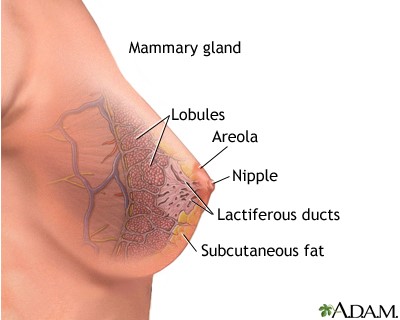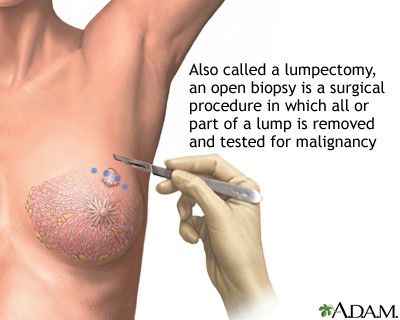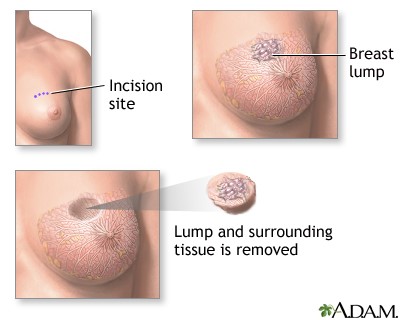Breast cancer
Breast cancer is cancer that starts in the tissues of the breast. There are two main types of breast cancer:
· Ductal carcinoma starts in the tubes (ducts) that carry milk from the breast to the nipple. Most breast cancers are of this type.
· Lobular carcinoma starts in the parts of the breast, called lobules, which produce milk.
In rare cases, breast cancer can start in other areas of the breast.

Causes
Over the course of a lifetime, 1 in 8 women will be diagnosed with breast cancer.
Risk factors you cannot change include:
· Age and gender -- Your risk of developing breast cancer increases as you get older. Most advanced breast cancer cases are found in women over age 50. Men can also get breast cancer. But they are 100 times less likely than women to get breast cancer.
· Family history of breast cancer -- You may also have a higher risk of breast cancer if you have a close relative who has had breast,UTERINE, ovarian, or colon cancer.
· Genes -- The most common gene defects are found in the BRCA1 and BRCA2 genes. These genes normally produce proteins that protect you from cancer. If a parent passes you a defective gene, you have an increased risk of breast cancer. Women with one of these defects have up to an 80% chance of getting breast cancer sometime during their life.
· Menstrual cycle -- Women who got their periods early (before age 12) or went through menopause late (after age 55) have an increased risk of breast cancer.
Other risk factors include:
· Alcohol use -- Drinking more than 1 to 2 glasses of alcohol a day may increase your risk of breast cancer.
· Childbirth -- Women who have never had children or who had their first child after age 30 have an increased risk of breast cancer. Being pregnant more than once or becoming pregnant at an early age reduces your risk of breast cancer.
· DES -- Women who took diethylstilbestrol (DES) to prevent miscarriage may have an increased risk of breast cancer after age 40. This drug was given to women in the 1940s through the 1960s.
· Hormone therapy (HT) -- You have a higher risk of breast cancer if you received hormone therapy with estrogen for several years.
· Obesity -- Obesity has been linked to breast cancer, although this link is not well understood. Experts think that obese women produce more estrogen. This may fuel the development of breast cancer.
· Radiation -- If you received radiation therapy as a child or young adult to treat cancer of the chest area, you have a very high risk of developing breast cancer. The younger you started such radiation and the higher the dose, the higher your risk. This is especially true if the radiation was given during breast development.
Breast implants, using antiperspirants, and wearing underwire bras do not increase the risk of breast cancer. There is also no evidence of a direct link between breast cancer and pesticides.
Symptoms
Early breast cancer usually does not cause symptoms. This is why regular breast exams are important. As the cancer grows, symptoms may include:
· Breast lump or lump in the armpit that is hard, has uneven edges, and usually does not hurt
· Change in the size, shape, or feel of the breast or nipple -- for example, you may have redness, dimpling, or puckering that looks like the skin of an orange
· Fluid from the nipple -- may be bloody, clear to yellow, green, or look like pus
In men, breast cancer symptoms include breast lump and breast pain and tenderness.
Symptoms of advanced breast cancer may include:
· Bone pain
· Breast pain or discomfort
· Skin ulcers
· Swelling of the lymph nodes in the armpit (next to the breast with cancer)
· Weight loss
Exams and Tests
The doctor will ask about your symptoms and risk factors. Then the doctor will perform a physical exam. The exam includes both breasts, armpits, and the neck and chest area.
Women are encouraged to perform breast self-exams each month. However, the importance of self-exams for detecting breast cancer is debatable.

Tests used to diagnose and monitor patients with breast cancer may include:
· Breast MRI to help better identify the breast lump or evaluate an abnormal change on a mammogram
· Breast ultrasound to show whether the lump is solid or fluid-filled
· Breast biopsy, using methods such as needle aspiration, ultrasound-guided, stereotactic, or open
· CT scan to check if the cancer has spread outside the breast
· Mammography to screen for breast cancer or help identify the breast lump
· PET scan to check if the cancer has spread
· Sentinel lymph node biopsy to check if the cancer has spread to the lymph nodes
If your doctor learns that you do have breast cancer, more tests will be done. This is called staging, which checks if the cancer has spread. Staging helps guide treatment and follow-up. It also gives you an idea of what to expect in the future.

Breast cancer stages range from 0 to IV. The higher the stage, the more advanced the cancer.

Treatment
Treatment is based on many factors, including:
· Type and stage of the cancer
· Whether the cancer is sensitive to certain hormones
· Whether the cancer overproduces (overexpresses) the HER2/neu gene
Cancer treatments may include:
· Chemotherapy, which uses medicines to kill cancer cells.
· Radiation therapy, which is used to destroy cancerous tissue.
· Surgery to remove cancerous tissue: A lumpectomy removes the breast lump; mastectomy removes all or part of the breast and possibly nearby structures.
· Targeted therapy uses medicine to attack the gene changes in cancer cells. Hormone therapy is an example of targeted therapy. It blocks certain hormones that fuel cancer growth.

Cancer treatment can be local or systemic:
· Local treatments involve only the area of disease. Radiation and surgery are forms of local treatment. They are most effective when the cancer has not spread outside the breast.
· Systemic treatments affect the entire body. Chemotherapy and hormonal therapy are types of systemic treatment.
Most women receive a combination of treatments. For women with stage I, II, or III breast cancer, the main goal is to treat the cancer and prevent it from returning (curing). For women with stage IV cancer, the goal is to improve symptoms and help them live longer. In most cases, stage IV breast cancer cannot be cured.
· Stage 0 and ductal carcinoma -- Lumpectomy plus radiation or mastectomy is the standard treatment.
· Stage I and II -- Lumpectomy plus radiation or mastectomy with lymph node removal is the standard treatment. Chemotherapy, hormonal therapy, and other targeted therapy may also be used after surgery.
· Stage III -- Treatment involves surgery, possibly followed by chemotherapy, hormone therapy, and other targeted therapy.
· Stage IV -- Treatment may involve surgery, radiation, chemotherapy, hormone therapy, other targeted therapy, or a combination of these treatments.
After treatment, some women continue to take medicines for a time. All women continue to have blood tests, mammograms, and other tests after treatment.
Women who have had a mastectomy may have reconstructive breast surgery. This will be done either at the time of mastectomy or later.
Outlook (Prognosis)
New, improved treatments are helping persons with breast cancer live longer. Even with treatment, breast cancer can spread to other parts of the body. Sometimes, cancer returns even after the entire tumor has been removed and nearby lymph nodes are found to be cancer-free.
Some women who have had breast cancer develop a new breast cancer that is not related to the original tumor.
How well you do after being treated for breast cancer depends on many things. The more advanced your cancer, the poorer the outcome. Other factors that determine the risk of recurrence and the likelihood of successful treatment include:
· Location of the tumor and how far it has spread
· Whether the tumor is hormone receptor-positive or -negative
· Tumor markers
· Gene expression
· Tumor size and shape
· Rate of cell division or how quickly the tumor is growing
After considering all of the above, your doctor can discuss your risk of having a recurrence of breast cancer.
Possible Complications
You may experience side effects or complications from cancer treatment. These may include temporary pain or swelling of the breast and surrounding area. Ask your doctor about the possible side effects from treatment.
When to Contact a Medical Professional
Contact your health care provider if:
· You have a breast or armpit lump
· You have nipple discharge
Call your health care provider if you develop symptoms after being treated for breast cancer:
· Nipple discharge
· Rash on the breast
· New lumps in the breast
· Swelling in the area
· Pain, especially chest pain, abdominal pain, or bone pain
Prevention
Talk to your health care provider about how often you should have a mammogram. Early breast cancers found by a mammogram have a good chance of being cured.
Tamoxifen is approved for breast cancer prevention in women age 35 and older who are at high risk. Discuss this with your doctor.
Women at very high risk of breast cancer may consider preventive (prophylactic) mastectomy. This is surgery to remove the breasts before breast cancer is diagnosed. Possible candidates include:
· Women who have already had one breast removed due to cancer
· Women with a strong family history of breast cancer
· Women with genes or genetic mutations that raise their risk of breast cancer (such as BRCA1 or BRCA2)
Many risk factors, such as your genes and family history, cannot be controlled. But making healthy lifestyle changes may reduce your overall chance of getting cancer. This includes:
· Eating healthy foods
· Maintaining a healthy weight
· Limiting alcohol consumption to 1 drink per day (women at high risk of breast cancer should not drink alcohol at all)
Alternative Names
Cancer - breast; Carcinoma - ductal; Carcinoma - lobular; DCIS; LCIS; HER2-positive breast cancer; ER-positive breast cancer; Ductal carcinoma in situ; Lobular carcinoma in situ

